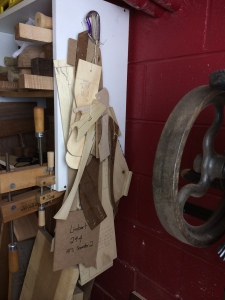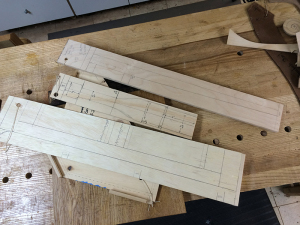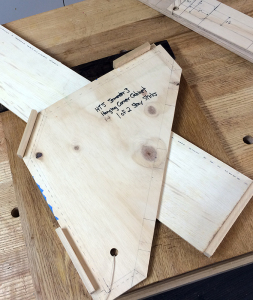Tell Me a Story
 What story does your work tell? Documenting and telling a story was one of the primary reasons I started this blog actually. For years I was building stuff and either selling it or giving it family and never taking any pictures or documenting the process for my own benefit. I build a lot of one off stuff, not so much on purpose though. If I had had the forethought to document things and make patterns I may have made some of these old projects again.
What story does your work tell? Documenting and telling a story was one of the primary reasons I started this blog actually. For years I was building stuff and either selling it or giving it family and never taking any pictures or documenting the process for my own benefit. I build a lot of one off stuff, not so much on purpose though. If I had had the forethought to document things and make patterns I may have made some of these old projects again.
So it was about 5 years ago that I got into the habit of making patterns and story sticks when I build a piece of furniture. Sometimes what I’m building doesn’t really lend itself to a pattern but a story stick is not a bad idea if you think you will ever build that object again. Now hanging on the wall I have a stack of patterns and story sticks just waiting to be put to use in making one of these pieces again. Sometimes it is fun to take them down and look through them like one looks through a photo album. They remind you of past triumphs and defeats, problems solved and created, and many many hours of fun in the shop. In my case they tell another story too. The carabiner that they are all clipped to actually saved my life about 500 feet up a rock wall in Eldorado canyon back in college.
 Some of these I use as actual patterns to create multiple pieces the same shape. Moulding profiles and curved parts, rely on these patterns whether you shape your pieces by hand or with something like a template bit and router. In my case I spend a lot of time perfecting a curve and shape using an 1/8″ or 1/4″ piece of plywood or MDF and it is much easier to get it the way I want with this thinner material. So not only am I ensuring I can duplicate my parts, I’m working out a design at full size. Then I trace them and saw and plane/rasp/file to the line.
Some of these I use as actual patterns to create multiple pieces the same shape. Moulding profiles and curved parts, rely on these patterns whether you shape your pieces by hand or with something like a template bit and router. In my case I spend a lot of time perfecting a curve and shape using an 1/8″ or 1/4″ piece of plywood or MDF and it is much easier to get it the way I want with this thinner material. So not only am I ensuring I can duplicate my parts, I’m working out a design at full size. Then I trace them and saw and plane/rasp/file to the line.
 Others are more guide than pattern. I’m not trying to reproduce a shape but more looking for a repetitive way to lay out something. Turned objects are a good example. Not only can I work out the shape to scale while drawing the pattern, but once formed I can use it to lay out lines while at the lathe. I can also use my calipers to set diameter right off the pattern and use a parting tool to create my depth guides on the lathe.
Others are more guide than pattern. I’m not trying to reproduce a shape but more looking for a repetitive way to lay out something. Turned objects are a good example. Not only can I work out the shape to scale while drawing the pattern, but once formed I can use it to lay out lines while at the lathe. I can also use my calipers to set diameter right off the pattern and use a parting tool to create my depth guides on the lathe.
Other times I use the story stick to precisely lay out joinery locations on multiple pieces. Items like doors and case pieces don’t have much in the way of curve pieces to be traced but the location of the mortises and other joinery is absolutely essential to make square pieces that look the same.
 To this end, I will sometimes add fences to my story sticks. Now I can take a project piece and but it up against the fence and ensure all my lay out lines ends up in exactly the same place on every part. This is usually nothing more than a 1/4″ or 1/2″ piece of scrap glued to the edge of the pattern but it is really helpful while in the heat of joinery layout. In some instances like the corner cabinet pattern shown, I have more than one fence to precisely locate a piece. This is really up to you and how you plan to use the story stick.
To this end, I will sometimes add fences to my story sticks. Now I can take a project piece and but it up against the fence and ensure all my lay out lines ends up in exactly the same place on every part. This is usually nothing more than a 1/4″ or 1/2″ piece of scrap glued to the edge of the pattern but it is really helpful while in the heat of joinery layout. In some instances like the corner cabinet pattern shown, I have more than one fence to precisely locate a piece. This is really up to you and how you plan to use the story stick.
Finally, it is your story stick so tell the story you want. Some of us will just lay in joinery locations, while others draw in many more details. Of course I label all of mine and I often will use them throughout the build to take notes about my process.
 Sometimes I just glue a parts list right to the pattern. I add tiny details and revelations that occurred during the build. In every instance I will try to add something at actual scale. Cross sections of moulding profiles are especially helpful so I can set my dividers or marking gauges from the drawing and lay out my pieces for sticking by hand. These drawing can be especially useful in creating a scratch stock for smoothing a moulding too.
Sometimes I just glue a parts list right to the pattern. I add tiny details and revelations that occurred during the build. In every instance I will try to add something at actual scale. Cross sections of moulding profiles are especially helpful so I can set my dividers or marking gauges from the drawing and lay out my pieces for sticking by hand. These drawing can be especially useful in creating a scratch stock for smoothing a moulding too.
The idea here is that I want to be able to return to this story stick years in the future and be able to build the piece again without having to do any additional problem solving. A stranger should be able to dig up your story sticks 1000 years in the future and do the same.
So tell your story and do it thoroughly. Every time I add a pattern to the wall I am proud of what I have made and this remains as a testament to that project. It may be on the other side of the world but I still have a record of its building. I think about walking through the shops of highly experience woodworkers who have done this and what a story their shops have to tell with row after row of patterns hanging from the ceiling or walls. It is a clutter of inspiration that only a woodworker could love.


